It’s no surprise that the Saluki, aka the Persian Greyhound, is often confused with the Greyhound. They are not only quite similar in appearance but also very swift dogs. The Saluki has been clocked at 43 mph in the Guinness Book of Records since 1996. Due to their endurance, greyhounds are frequently utilized in racing tournaments and run at speeds of up to 40mph. So, with so much in common, how are these two cousins distinct? In this post, we shall contrast the Saluki and the greyhound in 8 key areas.
Saluki vs. Greyhound: A Comparison
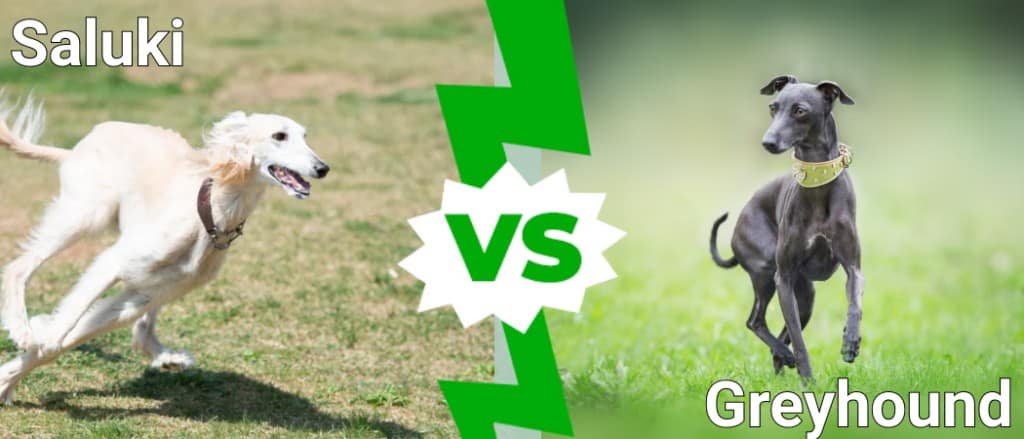
| Key Differences | Saluki | Greyhound |
| Height | 23 – 28 inches | 27 – 30 inches |
| Weight | 29 to 66 lbs. | 60 to 100 lbs. |
| Coat type | Short, Smooth, Feathery | Short, Silky |
| Colors | Chocolate, Fawn, Tan, Golden, Silver, Black | Fawn, Blue, Gray, Red, White, Black |
| Temperament | Aloof, Quiet, Loyal, Reserved | Social, Non-Aggressive, Wary of Strangers |
| Pet / Child Friendly | Average | Below Average |
| Energy Levels | High | Low |
| Health Problems | Heart Issues, Hip Dysplasia, Hypothyroidism | Bloating, Cancer, Heart Issues |
Key Differences Between Saluki and Greyhound
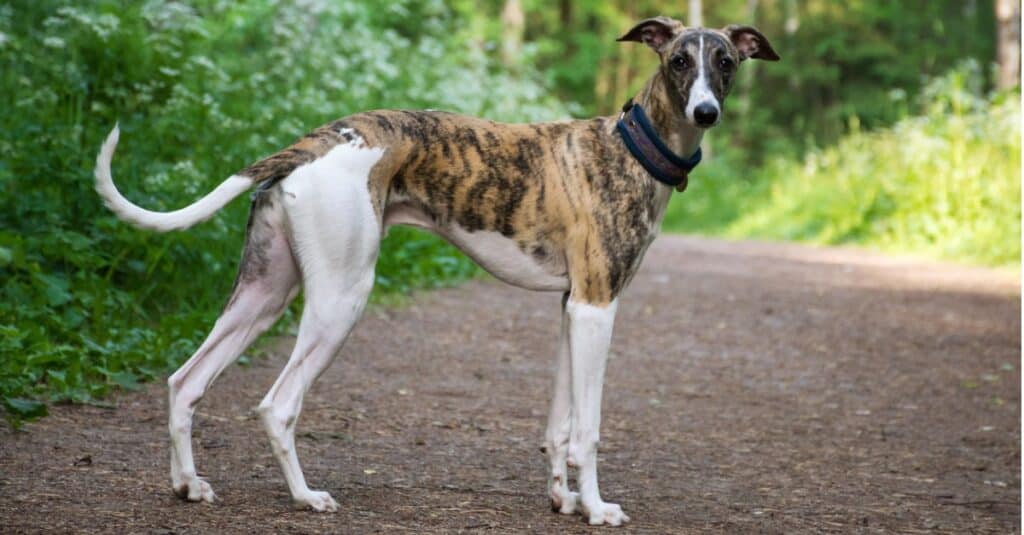
The Greyhound is considered to be the fastest dog in the world, although the Saluki is thought to be faster over long distances.
©iStock.com/Natalia Timchenko
These two hound dog breeds are known for their speed and love of running. Although each Saluki is unique, they always share a greyhound-like physique with long, slender legs and an upright chest, a small waist, and a long tail. It is smaller, angular, and thinner than the Greyhound, which makes the Saluki unique.
Long, floppy ears with feathered fur distinguish the Saluki from the Greyhound as well. Known as “rose ears,” a Greyhound’s ears are upright at the base but fall out and back like petals. Here are some more noteworthy differences between these two fascinating breeds that you should know about!
Appearance

Despite a common misconception, however, the Saluki is not hyperactive. They just require a lot of physical activity and mental stimulation due to their alert nature.
©Elisabetta Bellomi/Shutterstock.com
Saluki vs. Greyhound: Height
The Saluki can grow to be up to 28 inches tall, whereas the Greyhound can grow to be up to 30 inches tall. Both are quite tall in comparison to most canines.
Saluki vs. Greyhound: Weight
The Saluki is a large dog, weighing anything from 29 to 66 pounds. The Greyhound is considered a Giant dog breed and can weigh all the way up to 100 pounds.
Saluki vs. Greyhound: Coat Type

The Saluki can be distinguished from the Greyhound by its floppy, feathery-covered ears.
©otsphoto/Shutterstock.com
Salukis have lengthy, silky hair on the ears, under the tail, between the toes, and occasionally on the flanks of the legs and under the throat. They have a short, soft coat over the rest of the body. They are a low-shedding breed that is also quite easy to groom; a simple brushing once or twice a week is all that is required to keep their coat healthy.
Greyhounds have a short, smooth coat, but they require more bathing than Salukis, usually monthly. Neither is tough to groom.
Saluki vs. Greyhound: Colors
Diverse hues are available in both the Saluki and the Greyhound. Greyhounds come in a variety of colors, including gray, white, blue, red, and black. All these colors and more can be found in the Saluki’s various breeds: Chocolate Fawn; Red; White; Tan; Cream; Golden; Silver; and Black.
Characteristics
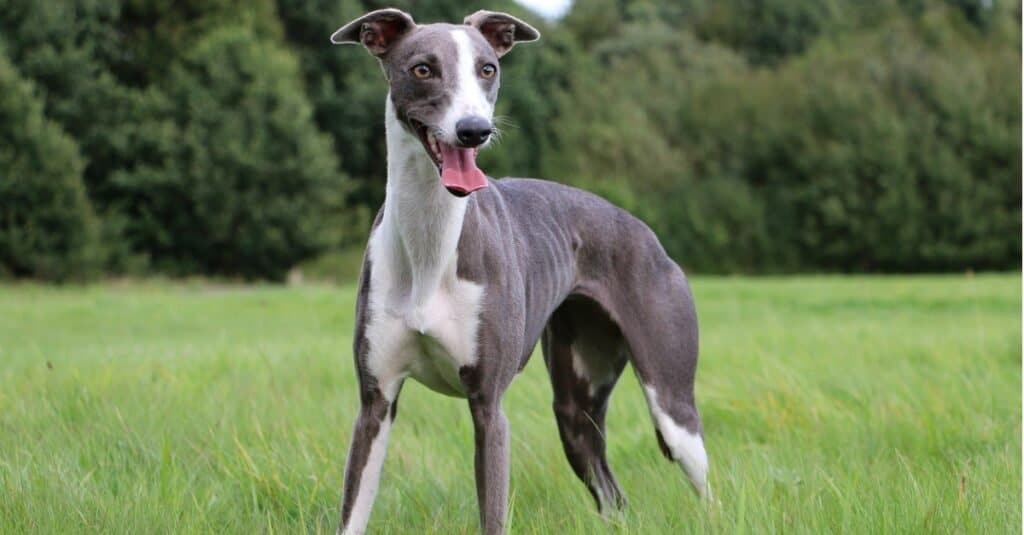
Greyhounds are very playful pups but they also like to just cuddle in their dog bed with their favorite toys.
©iStock.com/BiancaGrueneberg
Saluki vs. Greyhound: Temperament
The Greyhound, despite being shy, gets along better with strangers and adapts better to apartment life than the Saluki. Greyhounds aren’t generally good guard dogs. Despite their size, they are not aggressive towards people and are actually very calm dogs compared to most dog breeds.
The Saluki is an alert, easygoing, one-family dog who can be wary of outsiders. This loyal but reserved breed will enjoy sitting at your side rather than on your lap. They are good watchdogs but not so good protectors.
Saluki vs. Greyhound: Pet / Child Friendly
It’s common for Salukis to be calm at home, kind with kids, and friendly with other dogs. They’re not the best choice for families with young children or a lot of people who like to make a lot of noise.
Greyhounds are calm, affectionate, and easy to have a good relationship with. On the other hand, Greyhounds are not the best at being around youngsters and can get skittish, but not aggressive. However, if they are properly taught, socialized, and given the activity they need, they can be terrific companions for a home with kids. They may coexist more peacefully with older children because of their even temperaments.
Health Factors
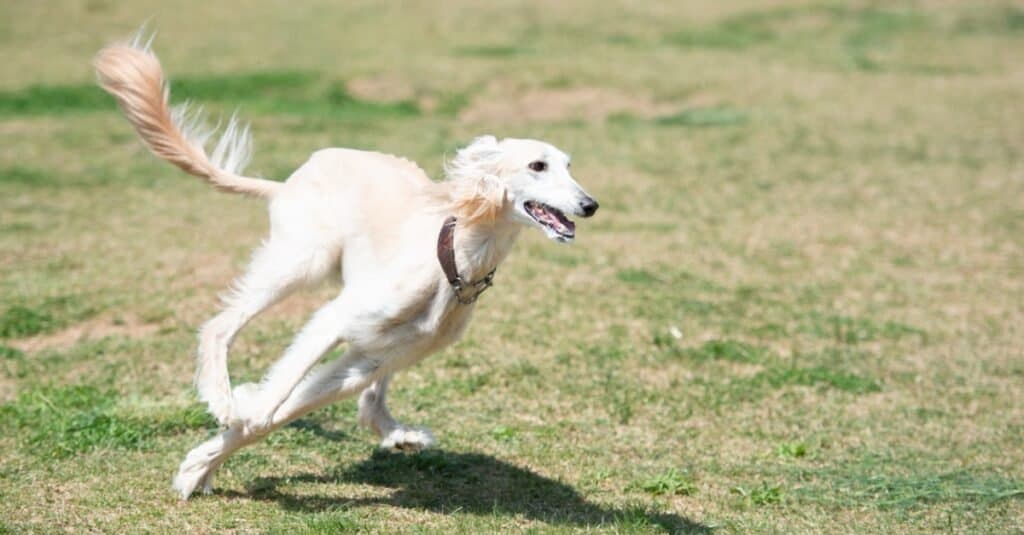
The Saluki can go as fast as 43 mph and can endure longer distances than the Greyhound. However, the Greyhound is faster in short spurts and is commonly used in dog racing tournaments.
©Purino/Shutterstock.com
Saluki vs. Greyhound: Energy Levels
Both the Greyhound and the Saluki have a lifespan of 12 to 14 years on average. Their longevity is heavily reliant on being able to meet their activity needs. For example, they are both runners and require regular exercise. However, the Greyhound is a low-energy dog by nature, whereas the Saluki is a high-energy dog. Salukis, as a result, need to be more active and are not keen on taking extended naps. The Greyhound is content to lounge around and sleep soundly when inside the home.
Saluki vs. Greyhound: Health Factors
Greyhounds are easy to care for, but they are more prone to certain health issues than most other canines. Top health concerns for the Greyhound include bloat, bone cancer, heart problems, allergies, eye problems, and deafness.
Salukis don’t appear to have as many health problems, but they do have higher expectations in terms of stimulation and exercise than other breeds. Both breeds are vulnerable to extreme temperatures and hostile conditions because of their lack of body fat, long thin bones, and delicate skin.
Wrapping Up Saluki Vs. Greyhound
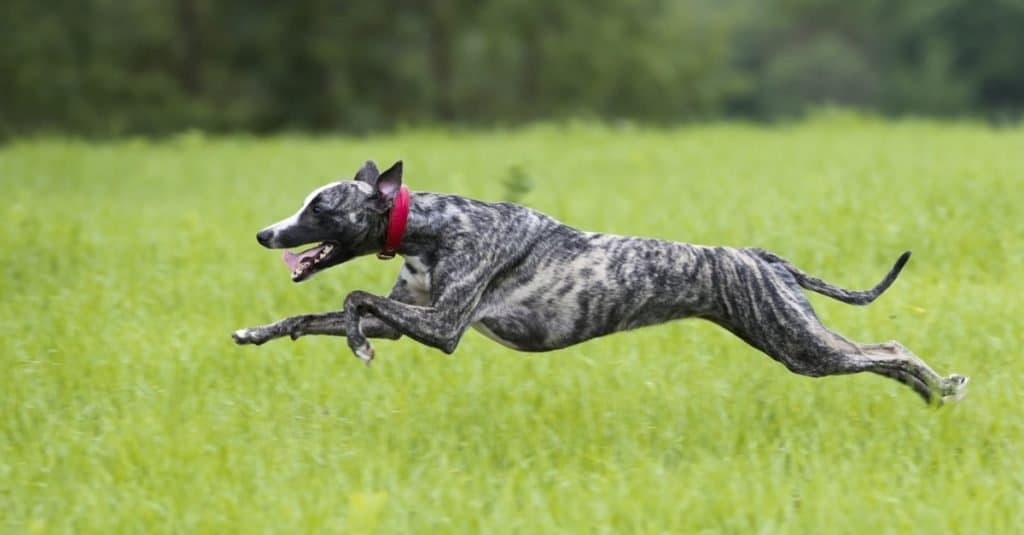
The incredibly fast greyhound is super laid back and loves to sleep when they are not out running.
©Liliya Kulianionak/Shutterstock.com
Even though these two canines are related and have a similar body type, they are quite different from one another. This can be seen in their specific activity and exercise requirements, temperament, and compatibility with people and other animals. Compared to other breeds, the Saluki is a lot more active and needs a lot of stimulation. Therefore, small places and owners who don’t spend a lot of time with their pets aren’t a good fit for this type of dog breed. In a calm household, the Greyhound is an excellent choice due to its naturally relaxed nature when it’s not running around. Both breeds are excellent companions for first-time pet owners because of their easygoing demeanor.
The photo featured at the top of this post is © nik174/Shutterstock.com
Ready to discover the top 10 cutest dog breeds in the entire world?
How about the fastest dogs, the largest dogs and those that are -- quite frankly -- just the kindest dogs on the planet? Each day, AZ Animals sends out lists just like this to our thousands of email subscribers. And the best part? It's FREE. Join today by entering your email below.
Thank you for reading! Have some feedback for us? Contact the AZ Animals editorial team.







